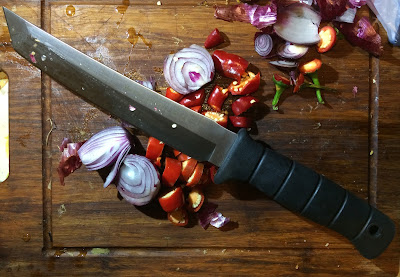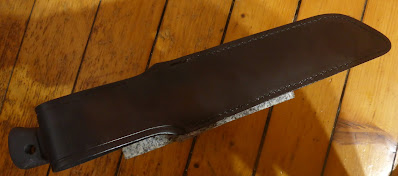Molibdeno Vanadio
What sort of knife steel is this?
Ok, so firstly, let me say where one would encounter such a knife steel designation. A lot of Spanish made knives may carry this designation upon their blades. Simply speaking it just means a knife steel which contains both the elements Molybdenum and Vanadium.
So which steels contain those elements in significant percentages?
Assuming Spanish knife makers are actually using Spanish made stainless steel (Spain is one of the worlds biggest manufacturers of Stainless steels); we can take some data from the company Acerinox in Spain, the following information:
We can see that steels such as EN 1.4116/420 MOV (X50CrMOV15) although Vanadium is only present as trace percentages (0.1-0.2%) ,
EN1.4116 is NOT a 440 series stainless. There is no vanadium in the 440 series of stainless steels.
Lets have a look at a typical example here, the Muela Tanto 19W a 5mm thick full tang injection moulded synthetic rubber grip tactical knife from the tactical knife product line of Muela in Spain. Past 2020, various versions can be found of the knife sporting different steel designations, some with the numbers 440 and Molibdeno Vanadio, an impossible designation-unless a proprietary alloy (it could be possible Muela is a BIG company). There have also been various blade geometries available, ie sabre flat grind or a hollow ground blade. This one shown here sports a sabre flat grind, feels hefty and strong and is certainly very grippy and comfortable to hold.
It came out of the box, deadly, deadly sharp, with a very well stitched cow hide and partial ballistic nylon scabbard.
What is the HRC of this knife because Muela do not specify on their website?
Well it could be almost up to 59 (58.8) if there is any contaminating Nitrogen but if zero Nitrogen then we can expect a HRC of approximately HRC of 56.
For the stainless steel, 1.4110, generally there is no Vanadium in this martensitic stainless steel, although higher in carbon content than 1.4116, so Molibdeno Vanadio is NOT 1.4110 stainless steel either.
If we settle upon 1.4116 what is the actual compositional range*?
For example: Muela is one of the well-known Spanish manufacturers and is not specifying exactly the steel composition, of 1.4116 as in it could have some Nitrogen? which if it did, it would contribute to the end characteristics of the alloy. It has been shown that a very small addition of the element, Nitrogen (N) can increase the hardness, toughness and corrosion resistance of ordinary 1.4116**.
So at the end of the day the "Molibdeno Vanadio" might in fact be a modification of the the 440 series. What do I base this upon? Well Aitor another very well known manufacturer always said their steel was an improvement (so in other words a modification) of 440C and they too list Mo and vanadium as key elements. Who knows maybe it is, so unless you're fluent in metallurgy and in Spanish and happen to work within the Spanish knife making industry, especially selling raw material to these knife makers, then you'll never know!
It seems if it was simply 1.4116 then it would be marked as such is my guess. At the end of the day, it shouldn't be a name/designation which halts the purchase of something one likes, it should be because one likes it and if it also performs well in its given role then the steel could be XYZ for all I care.
Besides that, I'll bet most can't tell the difference anyway unless they shove a sample inside an SEM for some EDAX, something I did on a regular basis for almost ten years and it was always a surprise (sometimes pleasant, sometimes not) for the clients!
The difference I find between Aitor knives and Muela, is that Muela knives always come with a quality evenly ground edge, where as Aitor, unfortunately now, have a sloppy edge finish. At least on the last two classic Aitor knives I have purchased, and you forget about contacting them because they are a faceless company as well and never answer any emails or facebook inquiries. Although to be fair I have found this with a great many companies who have become "big", customer service is not a strong point let alone a seriously undertaken activity. All that being said, the quality here with respect to the Muela Tanto 19W is good. The only negative point is that there are no keyways upon the tang to stop the slippage of the injection moulded handle. Or that they simply let out a batch of knives without an end metal rivet (as seen on my very old but trusty Ontario Spec Plus-where a brass rivet makes it impossible for the grip to slip (I think there are no keyways on this knife's tang either. As mentioned, I'll insert, either a piece of fibreglass tubing or an off cut from an aluminium hunting arrow and this will render the grip immovable.
Some quick metallurgy:
Now as to the metallurgy of 1.4116 read about some scientific facts, not some YouTube non scientific gossip.
**





No comments:
Post a Comment